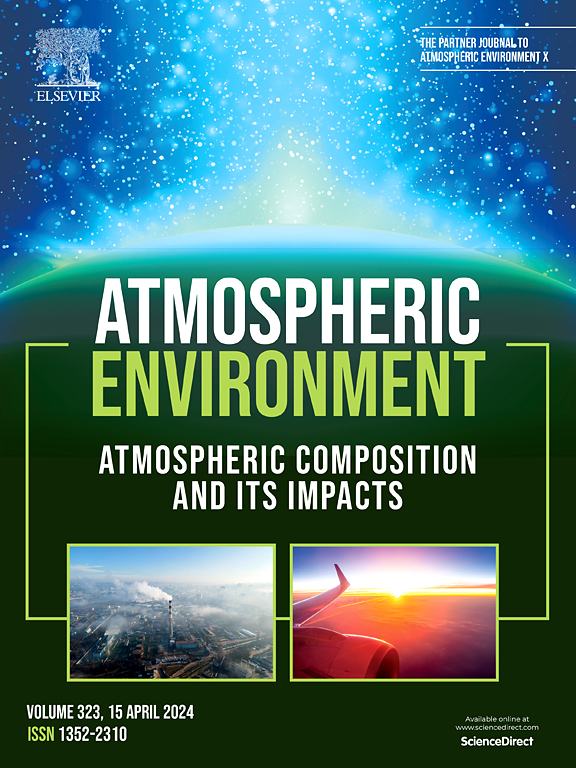Particulate matter (PM) and ozone air quality in Urumqi of Northwest China: Seasonality, trends, and sources
IF 4.2
2区 环境科学与生态学
Q2 ENVIRONMENTAL SCIENCES
引用次数: 0
Abstract
The city of Urumqi experiences severe air pollution, for which the variations and causes remain unclear. Here, we comprehensively investigate the seasonality, trends, and drivers of fine and coarse particulate matter (PM2.5 and PM2.5-10) and ozone (O3) in Urumqi in the Chinese national context by statistical analysis of surface and satellite observations during 2015–2023. Wintertime PM2.5 in Urumqi is twice as high as that averaged over Eastern China due to intensive emissions and unfavourable topography and meteorology, monthly PM2.5-10 in Urumqi of above 40 μg m−3 year-round is driven by spring and autumn natural dust episodes and ubiquitous anthropogenic fugitive dust. During 2015–2023, PM2.5 and PM2.5-10 decreased by 34–38% credited to emissions control. However, the maximum daily 8h average (MDA8) O3 in Urumqi increases rapidly at a rate of 2.5 ppbv yr−1 due to increased volatile organic compounds (VOCs), decreased nitrogen oxides (NOx) in earlier years of 2015–2016, and decreased PM2.5. Impacts from VOCs and NOx emission changes are supported by summertime O3 formation regime transits from VOCs-limited to NOx and VOCs co-limited during 2015–2023 as depicted by surface O3-nitrogen dioxide (NO2) correlations and satellite formaldehyde (HCHO)/NO2 ratios. Responses of PM2.5, PM2.5-10, O3, and related gases during the 2020 winter and summer epidemic lockdowns conform to our findings for their 2015–2023 trends. This study concludes that joint NOx and VOCs emissions control would be particularly effective in reducing PM2.5 and O3 in Urumqi. This study also provides references for studying air quality in other places with limited observations.

中国西北乌鲁木齐市颗粒物(PM)和臭氧空气质量:季节性、趋势和来源
乌鲁木齐市经历了严重的空气污染,其变化和原因尚不清楚。本文通过2015-2023年地面和卫星观测数据的统计分析,全面探讨了乌鲁木齐市细、粗颗粒物(PM2.5和PM2.5-10)和臭氧(O3)的季节性、变化趋势及其驱动因素。由于排放强度大、地形和气象条件不利,乌鲁木齐市冬季PM2.5是中国东部平均水平的2倍,全年PM2.5月平均值在40 μg m−3以上,主要受春秋两季自然扬尘和普遍存在的人为扬尘的驱动。2015-2023年,由于排放控制,PM2.5和PM2.5-10下降了34-38%。2015-2016年前期,由于挥发性有机化合物(VOCs)增加,氮氧化物(NOx)减少,PM2.5下降,乌鲁木乌鲁木市最大日8h平均值(MDA8) O3以2.5 ppbv / yr - 1的速度快速增加。表层臭氧-二氧化氮(NO2)相关性和卫星甲醛(HCHO)/NO2比值表明,2015-2023年夏季臭氧形成状态从VOCs限制转变为NOx和VOCs共同限制,支持了VOCs和NOx排放变化的影响。在2020年冬季和夏季疫情封锁期间,PM2.5、PM2.5-10、O3和相关气体的响应符合我们对其2015-2023年趋势的研究结果。研究认为,乌鲁木齐市氮氧化物和挥发性有机化合物联合控制排放对降低PM2.5和O3尤为有效。本研究也为其他观测有限地区的空气质量研究提供了参考。
本文章由计算机程序翻译,如有差异,请以英文原文为准。
求助全文
约1分钟内获得全文
求助全文
来源期刊

Atmospheric Environment
环境科学-环境科学
CiteScore
9.40
自引率
8.00%
发文量
458
审稿时长
53 days
期刊介绍:
Atmospheric Environment has an open access mirror journal Atmospheric Environment: X, sharing the same aims and scope, editorial team, submission system and rigorous peer review.
Atmospheric Environment is the international journal for scientists in different disciplines related to atmospheric composition and its impacts. The journal publishes scientific articles with atmospheric relevance of emissions and depositions of gaseous and particulate compounds, chemical processes and physical effects in the atmosphere, as well as impacts of the changing atmospheric composition on human health, air quality, climate change, and ecosystems.
 求助内容:
求助内容: 应助结果提醒方式:
应助结果提醒方式:


